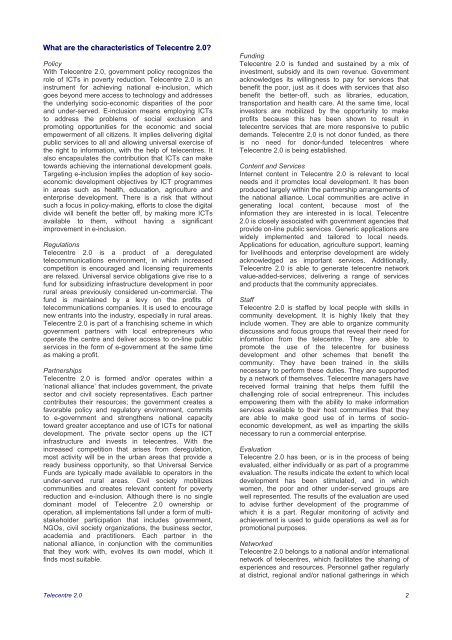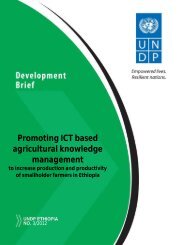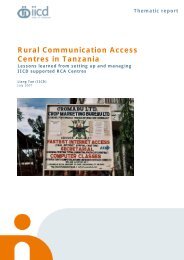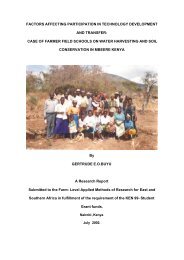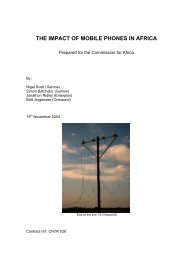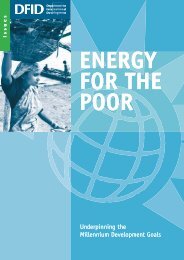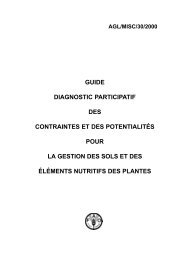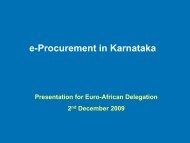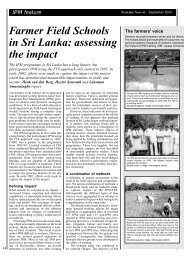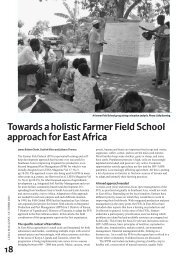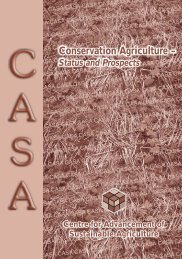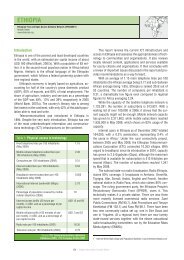Instructions for Formatting Papers - Share4Dev.info
Instructions for Formatting Papers - Share4Dev.info
Instructions for Formatting Papers - Share4Dev.info
You also want an ePaper? Increase the reach of your titles
YUMPU automatically turns print PDFs into web optimized ePapers that Google loves.
What are the characteristics of Telecentre 2.0?<br />
Policy<br />
With Telecentre 2.0, government policy recognizes the<br />
role of ICTs in poverty reduction. Telecentre 2.0 is an<br />
instrument <strong>for</strong> achieving national e-inclusion, which<br />
goes beyond mere access to technology and addresses<br />
the underlying socio-economic disparities of the poor<br />
and under-served. E-inclusion means employing ICTs<br />
to address the problems of social exclusion and<br />
promoting opportunities <strong>for</strong> the economic and social<br />
empowerment of all citizens. It implies delivering digital<br />
public services to all and allowing universal exercise of<br />
the right to in<strong>for</strong>mation, with the help of telecentres. It<br />
also encapsulates the contribution that ICTs can make<br />
towards achieving the international development goals.<br />
Targeting e-inclusion implies the adoption of key socioeconomic<br />
development objectives by ICT programmes<br />
in areas such as health, education, agriculture and<br />
enterprise development. There is a risk that without<br />
such a focus in policy-making, ef<strong>for</strong>ts to close the digital<br />
divide will benefit the better off, by making more ICTs<br />
available to them, without having a significant<br />
improvement in e-inclusion.<br />
Regulations<br />
Telecentre 2.0 is a product of a deregulated<br />
telecommunications environment, in which increased<br />
competition is encouraged and licensing requirements<br />
are relaxed. Universal service obligations give rise to a<br />
fund <strong>for</strong> subsidizing infrastructure development in poor<br />
rural areas previously considered un-commercial. The<br />
fund is maintained by a levy on the profits of<br />
telecommunications companies. It is used to encourage<br />
new entrants into the industry, especially in rural areas.<br />
Telecentre 2.0 is part of a franchising scheme in which<br />
government partners with local entrepreneurs who<br />
operate the centre and deliver access to on-line public<br />
services in the <strong>for</strong>m of e-government at the same time<br />
as making a profit.<br />
Partnerships<br />
Telecentre 2.0 is <strong>for</strong>med and/or operates within a<br />
‘national alliance’ that includes government, the private<br />
sector and civil society representatives. Each partner<br />
contributes their resources; the government creates a<br />
favorable policy and regulatory environment, commits<br />
to e-government and strengthens national capacity<br />
toward greater acceptance and use of ICTs <strong>for</strong> national<br />
development. The private sector opens up the ICT<br />
infrastructure and invests in telecentres. With the<br />
increased competition that arises from deregulation,<br />
most activity will be in the urban areas that provide a<br />
ready business opportunity, so that Universal Service<br />
Funds are typically made available to operators in the<br />
under-served rural areas. Civil society mobilizes<br />
communities and creates relevant content <strong>for</strong> poverty<br />
reduction and e-inclusion. Although there is no single<br />
dominant model of Telecentre 2.0 ownership or<br />
operation, all implementations fall under a <strong>for</strong>m of multistakeholder<br />
participation that includes government,<br />
NGOs, civil society organizations, the business sector,<br />
academia and practitioners. Each partner in the<br />
national alliance, in conjunction with the communities<br />
that they work with, evolves its own model, which it<br />
finds most suitable.<br />
Funding<br />
Telecentre 2.0 is funded and sustained by a mix of<br />
investment, subsidy and its own revenue. Government<br />
acknowledges its willingness to pay <strong>for</strong> services that<br />
benefit the poor, just as it does with services that also<br />
benefit the better-off, such as libraries, education,<br />
transportation and health care. At the same time, local<br />
investors are mobilized by the opportunity to make<br />
profits because this has been shown to result in<br />
telecentre services that are more responsive to public<br />
demands. Telecentre 2.0 is not donor funded, as there<br />
is no need <strong>for</strong> donor-funded telecentres where<br />
Telecentre 2.0 is being established.<br />
Content and Services<br />
Internet content in Telecentre 2.0 is relevant to local<br />
needs and it promotes local development. It has been<br />
produced largely within the partnership arrangements of<br />
the national alliance. Local communities are active in<br />
generating local content, because most of the<br />
in<strong>for</strong>mation they are interested in is local. Telecentre<br />
2.0 is closely associated with government agencies that<br />
provide on-line public services. Generic applications are<br />
widely implemented and tailored to local needs.<br />
Applications <strong>for</strong> education, agriculture support, learning<br />
<strong>for</strong> livelihoods and enterprise development are widely<br />
acknowledged as important services. Additionally,<br />
Telecentre 2.0 is able to generate telecentre network<br />
value-added-services, delivering a range of services<br />
and products that the community appreciates.<br />
Staff<br />
Telecentre 2.0 is staffed by local people with skills in<br />
community development. It is highly likely that they<br />
include women. They are able to organize community<br />
discussions and focus groups that reveal their need <strong>for</strong><br />
in<strong>for</strong>mation from the telecentre. They are able to<br />
promote the use of the telecentre <strong>for</strong> business<br />
development and other schemes that benefit the<br />
community. They have been trained in the skills<br />
necessary to per<strong>for</strong>m these duties. They are supported<br />
by a network of themselves. Telecentre managers have<br />
received <strong>for</strong>mal training that helps them fulfill the<br />
challenging role of social entrepreneur. This includes<br />
empowering them with the ability to make in<strong>for</strong>mation<br />
services available to their host communities that they<br />
are able to make good use of in terms of socioeconomic<br />
development, as well as imparting the skills<br />
necessary to run a commercial enterprise.<br />
Evaluation<br />
Telecentre 2.0 has been, or is in the process of being<br />
evaluated, either individually or as part of a programme<br />
evaluation. The results indicate the extent to which local<br />
development has been stimulated, and in which<br />
women, the poor and other under-served groups are<br />
well represented. The results of the evaluation are used<br />
to advise further development of the programme of<br />
which it is a part. Regular monitoring of activity and<br />
achievement is used to guide operations as well as <strong>for</strong><br />
promotional purposes.<br />
Networked<br />
Telecentre 2.0 belongs to a national and/or international<br />
network of telecentres, which facilitates the sharing of<br />
experiences and resources. Personnel gather regularly<br />
at district, regional and/or national gatherings in which<br />
Telecentre 2.0 2


